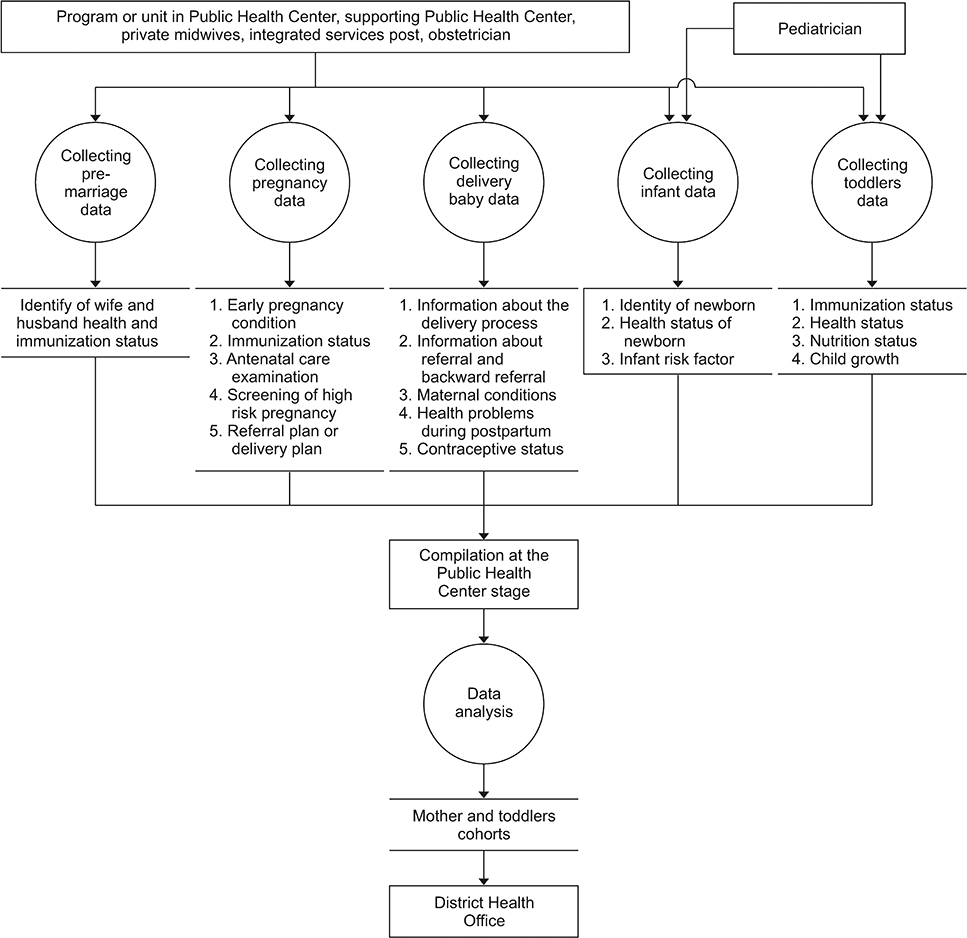Healthc Inform Res.
2019 Jul;25(3):153-160. 10.4258/hir.2019.25.3.153.
Integrated Information System for Early Detection of Maternal Risk Factors Based on Continuum of Care Approach of Mother and Toddler Cohorts
- Affiliations
-
- 1Faculty of Public Health, Universitas Airlangga, Surabaya, Indonesia. nyoman.anita3@gmail.com
- 2Faculty of Dental Medicine, Universitas Airlangga, Surabaya, Indonesia.
- 3Health Department, State Polytechnic of Jember, Jember, Indonesia.
- 4Centre for Business in Society, Coventry University, Coventry, UK.
- KMID: 2457467
- DOI: http://doi.org/10.4258/hir.2019.25.3.153
Abstract
OBJECTIVES
The aim of this study is to demonstrate how an integrated information system of mother and toddler cohorts can be developed as a basis of the continuum of care approach that subsequently can be used as the basis of early detection of risk factors of maternal mortality.
METHODS
This research was carried out qualitatively. The data was collected through three techniques: in-depth interviews, focus group discussion, and document studies at six public health centers located in four sub-districts of Surabaya, Indonesia. This research was conducted from 2016 to 2018.
RESULTS
The data collected from this research has become a basis input data requirement analysis for an integrated mother and toddler cohort information system. The system accommodates all the variables in each period of pre-marriage, pregnancy, labor, infancy and toddlerhood. The system facilitates healthcare workers to retrieve data and information related to mother and toddler health status.
CONCLUSIONS
The availability of various pieces of information enables the health status of mothers and toddlers to be monitored thoroughly throughout their long-life cycle. This continuum of care approach is beneficial in the early detection and management of risk factors of maternal mortality, such as pregnancy complications as well as childbirth and postpartum complications.
Keyword
MeSH Terms
Figure
Reference
-
1. East Java Provincial Health Office. Health profile of East Java Province in 2014. Surabaya, Indonesia: East Java Provincial Health Office;2014.2. Word Health Organization. Maternal mortality [Internet]. Geneva, Switzerland: Word Health Organization;c2019. cited at 2019 Apr 21. Available from: https://www.who.int/news-room/fact-sheets/detail/maternal-mortality.3. Word Health Organization. Sustainable Development Goals 3: Health [Internet]. Geneva, Switzerland: Word Health Organization;c2019. cited at 2019 Apr 21. Available from: https://www.who.int/topics/sustainable-development-goals/targets/en/.4. Steegers EA, von Dadelszen P, Duvekot JJ, Pijnenborg R. Pre-eclampsia. Lancet. 2010; 376(9741):631–644.
Article5. Magee LA, Helewa M, Rey E. Hypertension Guideline Committee. Strategic Training Initiative in Research in the Reproductive Health Sciences (STIRRHS) scholars. Diagnosis, evaluation, and management of the hypertensive disorders of pregnancy. J Obstet Gynaecol Can. 2008; 30:3 Suppl. S1–S2.
Article6. Duley L. The global impact of pre-eclampsia and eclampsia. Semin Perinatol. 2009; 33(3):130–137.
Article7. Word Health Organization. Chapter 3: Monitoring NCDs and their risk factors: a framework for surveillance [Internet]. Geneva, Switzerland: Word Health Organization;c2016. cited at 2019 May 16. Available from: https://www.who.int/nmh/publications/ncd_report_chapter3.pdf.8. Evashwick C. The continuum of long-term care. 3rd ed. New York (NY): Thomson/Delmar Learning;2005.9. Lawn J, Kerber K. Opportunities for Africa's newborns: practical data policy and programmatic support for newborn care in Africa. Cape Town, South Africa: Partnership for Maternal, Newborn and Child Health;2006. p. 24–28.10. Buragga KA, Zaman N. Software development techniques for constructive information systems design. Hershey, PA: IGI Global;2013. p. 118–123.11. Silver MS, Markus ML, Beath CM. The information technology interaction model: a foundation for the MBA core course. MIS Q. 1995; 19(3):361–390.
Article12. The Institute of Chartered Accountants of India. Information system control and audit. Nagpur, India: The Institute of Chartered Accountants of India;2015.13. Lemke G. The software development life cycle and its application [thesis]. Ypsilanti (MI): Eastern Michigan University;2018.14. O'Brien JA, Marakas GM. Management information systems. 10th ed. New York (NY): McGraw-Hill;2011.15. Like P, Sahama TR, Windsor CA, Huxley C. Designing a quality health information system: case study analysis of maternal and child health in Papua New Guinea. In : Proceedings of the 51st Annual Medical Symposium - Advancing Women's Health through Innovation; 2015 Aug 30–Sep 2; Papua New Guinea.16. Hennink MM. Focus group discussions. New York (NY): Oxford University Press;2014.17. Lippeveld T, Sauerborn R, Bodart C. Design and implementation of health information systems. Geneva, Switzerland: World Health Organization;2000.18. Bhattacharya M, Shahrawat R, Joon V. Understanding level of maternal and child health indicators used in Health Management Information System among peripheral level health functionaries in two districts of India. J Health Inform Dev Ctries. 2012; 6(1):385–395.19. Ovretveit J, Nelson E, James B. Building a learning health system using clinical registers: a non-technical introduction. J Health Organ Manag. 2016; 30(7):1105–1118.
Article20. Soontornpipit P, Taratep C, Teerawat W, Satitvipawee P, Piroonratana T. The study of hospital information systems in the 8th health region. Procedia Comput Sci. 2016; 86:252–256.
Article21. McBride S, Tietze M. Nursing informatics for the advanced practice nurse: patient safety, quality, outcomes, and interprofessionalism. New York (NY): Springer Publishing Company;2016.22. Ismail S, Alshmari M, Latif K, Ahmad HF. A granular ontology model for maternal and child health information system. J Healthc Eng. 2017; 2017:9519321.
Article23. Word Health Organization. Risk factors [Internet]. Geneva, Switzerland: Word Health Organization;c2017. cited at 2019 Apr 21. Available from: http://www.who.int/topics/risk_factors/en/.24. Chaudhry B, Wang J, Wu S, Maglione M, Mojica W, Roth E, Morton SC, Shekelle PG. Systematic review: impact of health information technology on quality, efficiency, and costs of medical care. Ann Intern Med. 2006; 144(10):742–752.
Article
- Full Text Links
- Actions
-
Cited
- CITED
-
- Close
- Share
- Similar articles
-
- Renovation of Maternal-child Healthcare Centers and the National Maternal-child Medical Center Based on the Mother and Child Act
- Integrated Care Center for High Risk Pregnancy and Neonate: An Analysis of Process and Problems in Obstetrics
- A Study of the Maternal Attachment Behavior During Early Postpartum Period
- Factors Influencing Maternal Depression: Secondary Data Analysis
- The study on the maternal burden of caretaking, the support and educational need for the caretaking activities of the infants' mother




